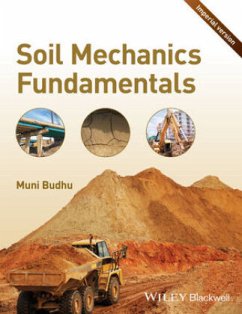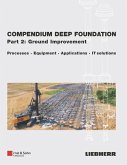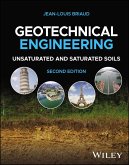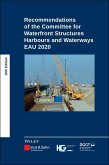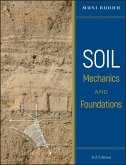Muni Budhu
Soil Mechanics Fundamentals (Imperial Version)
Muni Budhu
Soil Mechanics Fundamentals (Imperial Version)
- Broschiertes Buch
- Merkliste
- Auf die Merkliste
- Bewerten Bewerten
- Teilen
- Produkt teilen
- Produkterinnerung
- Produkterinnerung
- Ausgewogenes Verhältnis zwischen theoretischen Informationen und praktischen Anwendungen für die Einführung in die Bodenmechanik - Beschränkung der Mechanik auf ein Minimum, damit Studenten einen Einblick in die Hintergründe, Prämissen und Grenzen der Theorien gewinnen - Besprechungen der Implikationen der Leitideen vermitteln Studenten den mit der Anwendung dieser Ideen verbundenen Kontext - Moderne Erklärungen des Bodenverhaltens, insbesondere im Hinblick auf Bodensetzung und Bodenfestigkeit
Andere Kunden interessierten sich auch für
![Soil Mechanics Fundamentals (Metric Version) Soil Mechanics Fundamentals (Metric Version)]() Muni BudhuSoil Mechanics Fundamentals (Metric Version)54,99 €
Muni BudhuSoil Mechanics Fundamentals (Metric Version)54,99 €![Soil Properties and their Correlations Soil Properties and their Correlations]() Michael CarterSoil Properties and their Correlations76,99 €
Michael CarterSoil Properties and their Correlations76,99 €![Compendium Deep Foundation, Part 2: Ground Improvement Compendium Deep Foundation, Part 2: Ground Improvement]() Compendium Deep Foundation, Part 2: Ground Improvement98,00 €
Compendium Deep Foundation, Part 2: Ground Improvement98,00 €![Geotechnical Engineering Geotechnical Engineering]() Jean-Louis BriaudGeotechnical Engineering148,99 €
Jean-Louis BriaudGeotechnical Engineering148,99 €![Recommendations of the Committee for Waterfront Structures Harbours and Waterways. E-Bundle Recommendations of the Committee for Waterfront Structures Harbours and Waterways. E-Bundle]() Recommendations of the Committee for Waterfront Structures Harbours and Waterways. E-Bundle249,00 €
Recommendations of the Committee for Waterfront Structures Harbours and Waterways. E-Bundle249,00 €![Recommendations of the Committee for Waterfront Structures Harbours and Waterways Recommendations of the Committee for Waterfront Structures Harbours and Waterways]() Recommendations of the Committee for Waterfront Structures Harbours and Waterways149,00 €
Recommendations of the Committee for Waterfront Structures Harbours and Waterways149,00 €![Soil Mechanics and Foundations Soil Mechanics and Foundations]() Muni BudhuSoil Mechanics and Foundations304,99 €
Muni BudhuSoil Mechanics and Foundations304,99 €-
-
-
- Ausgewogenes Verhältnis zwischen theoretischen Informationen und praktischen Anwendungen für die Einführung in die Bodenmechanik
- Beschränkung der Mechanik auf ein Minimum, damit Studenten einen Einblick in die Hintergründe, Prämissen und Grenzen der Theorien gewinnen
- Besprechungen der Implikationen der Leitideen vermitteln Studenten den mit der Anwendung dieser Ideen verbundenen Kontext
- Moderne Erklärungen des Bodenverhaltens, insbesondere im Hinblick auf Bodensetzung und Bodenfestigkeit
Hinweis: Dieser Artikel kann nur an eine deutsche Lieferadresse ausgeliefert werden.
- Beschränkung der Mechanik auf ein Minimum, damit Studenten einen Einblick in die Hintergründe, Prämissen und Grenzen der Theorien gewinnen
- Besprechungen der Implikationen der Leitideen vermitteln Studenten den mit der Anwendung dieser Ideen verbundenen Kontext
- Moderne Erklärungen des Bodenverhaltens, insbesondere im Hinblick auf Bodensetzung und Bodenfestigkeit
Hinweis: Dieser Artikel kann nur an eine deutsche Lieferadresse ausgeliefert werden.
Produktdetails
- Produktdetails
- Verlag: Wiley / Wiley & Sons
- Artikelnr. des Verlages: 14557795000
- 1. Auflage
- Seitenzahl: 370
- Erscheinungstermin: 14. August 2015
- Englisch
- Abmessung: 250mm x 150mm x 17mm
- Gewicht: 816g
- ISBN-13: 9780470577950
- ISBN-10: 0470577959
- Artikelnr.: 41754677
- Herstellerkennzeichnung Die Herstellerinformationen sind derzeit nicht verfügbar.
- Verlag: Wiley / Wiley & Sons
- Artikelnr. des Verlages: 14557795000
- 1. Auflage
- Seitenzahl: 370
- Erscheinungstermin: 14. August 2015
- Englisch
- Abmessung: 250mm x 150mm x 17mm
- Gewicht: 816g
- ISBN-13: 9780470577950
- ISBN-10: 0470577959
- Artikelnr.: 41754677
- Herstellerkennzeichnung Die Herstellerinformationen sind derzeit nicht verfügbar.
Muniram (Muni) Budhu is Professor of Civil Engineering & Engineering Mechanics at the University of Arizona, Tucson, Arizona. He received his BSc (First Class Honors) in Civil Engineering from the University of the West Indies and his PhD in Soil Mechanics from Cambridge University, England. Prior to joining the University of Arizona, Dr. Budhu served on the faculty at the University of Guyana; McMaster University, Canada and the State University of New York at Buffalo. He spent sabbaticals as visiting Professor at St. Catherine's College, Oxford University; Eidgenössische Technische Hochschule Zürich(Swiss Federal Institute of Technology, Zurich), and theUniversity of Western Australia.
About the Author xi
Other Books by this Author xiii
Preface xv
Acknowledgments xix
Notes for Students and Instructors xxi
Notation, Abbreviations, Unit Notation, and Conversion Factors xxv
1 Composition and Particle Sizes of Soils 1
1.1 Introduction 1
1.2 Definitions of Key Terms 1
1.3 Composition of Soils 2
1.3.1 Soil formation 2
1.3.2 Soil types 2
1.3.3 Soil minerals 3
1.3.4 Surface forces and adsorbed water 5
1.3.5 Soil fabric 6
1.4 Determination of Particle Size 7
1.4.1 Particle size of coarse-grained soils 7
1.4.2 Particle size of fine-grained soils 9
1.5 Characterization of Soils Based on Particle Size 10
1.6 Comparison of Coarse-Grained and Fine-Grained Soils for Engineering Use 18
1.7 Summary 19
Exercises 19
2 Phase Relationships, Physical Soil States, and Soil Classification 23
2.1 Introduction 23
2.2 Definitions of Key Terms 23
2.3 Phase Relationships 24
2.4 Physical States and Index Parameters of Fine-Grained Soils 36
2.5 Determination of the Liquid, Plastic, and Shrinkage Limits 40
2.5.1 Casagrande's cup method: ASTM D 4318 40
2.5.2 Plastic limit test: ASTM D 4318 41
2.5.3 Shrinkage limit: ASTM D 427 and D 4943 42
2.6 Soil Classification Schemes 45
2.6.1 American Society for Testing and Materials and the Unified Soil Classification System (ASTM-USCS) 45
2.6.2 AASHTO soil classification system 45
2.6.3 Plasticity chart 49
2.7 Engineering Use Chart 50
2.8 Summary 54
2.8.1 Practical examples 54
Exercises 57
3 Soils Investigation 63
3.1 Introduction 63
3.2 Definitions of Key Terms 64
3.3 Purposes of a Soils Investigation 64
3.4 Phases of a Soils Investigation 65
3.5 Soils Exploration Program 66
3.5.1 Soils exploration methods 67
3.5.1.1 Geophysical methods 67
3.5.1.2 Destructive methods 71
3.5.2 Soil identification in the field 72
3.5.3 Number and depths of boreholes 75
3.5.4 Soil sampling 76
3.5.5 Groundwater conditions 78
3.5.6 Types of in situ or field tests 79
3.5.6.1 Vane shear test (VST): ASTM D 2573 80
3.5.6.2 Standard penetration test (SPT): ASTM D 1586 81
3.5.6.3 Cone penetrometer test (CPT): ASTM D 5778 87
3.5.6.4 Pressuremeter: ASTM D 4719-87 90
3.5.6.5 Flat plate dilatometer (DMT) 90
3.5.7 Soils laboratory tests 92
3.5.8 Types of laboratory tests 92
3.6 Soils Report 93
3.7 Summary 95
Exercises 96
4 One- and Two-Dimensional Flows of Water Through Soils 99
4.1 Introduction 99
4.2 Definitions of Key Terms 99
4.3 One-Dimensional Flow of Water Through Saturated Soils 100
4.4 Flow of Water Through Unsaturated Soils 103
4.5 Empirical Relationship for kz 103
4.6 Flow Parallel to Soil Layers 105
4.7 Flow Normal to Soil Layers 106
4.8 Equivalent Hydraulic Conductivity 106
4.9 Laboratory Determination of Hydraulic Conductivity 108
4.9.1 Constant-head test 108
4.9.2 Falling-head test 109
4.10 Two-Dimensional Flow of Water Through Soils 112
4.11 Flownet Sketching 114
4.11.1 Criteria for sketching flownets 115
4.11.2 Flownet for isotropic soils 116
4.12 Interpretation of Flownet 116
4.12.1 Flow rate 1
Other Books by this Author xiii
Preface xv
Acknowledgments xix
Notes for Students and Instructors xxi
Notation, Abbreviations, Unit Notation, and Conversion Factors xxv
1 Composition and Particle Sizes of Soils 1
1.1 Introduction 1
1.2 Definitions of Key Terms 1
1.3 Composition of Soils 2
1.3.1 Soil formation 2
1.3.2 Soil types 2
1.3.3 Soil minerals 3
1.3.4 Surface forces and adsorbed water 5
1.3.5 Soil fabric 6
1.4 Determination of Particle Size 7
1.4.1 Particle size of coarse-grained soils 7
1.4.2 Particle size of fine-grained soils 9
1.5 Characterization of Soils Based on Particle Size 10
1.6 Comparison of Coarse-Grained and Fine-Grained Soils for Engineering Use 18
1.7 Summary 19
Exercises 19
2 Phase Relationships, Physical Soil States, and Soil Classification 23
2.1 Introduction 23
2.2 Definitions of Key Terms 23
2.3 Phase Relationships 24
2.4 Physical States and Index Parameters of Fine-Grained Soils 36
2.5 Determination of the Liquid, Plastic, and Shrinkage Limits 40
2.5.1 Casagrande's cup method: ASTM D 4318 40
2.5.2 Plastic limit test: ASTM D 4318 41
2.5.3 Shrinkage limit: ASTM D 427 and D 4943 42
2.6 Soil Classification Schemes 45
2.6.1 American Society for Testing and Materials and the Unified Soil Classification System (ASTM-USCS) 45
2.6.2 AASHTO soil classification system 45
2.6.3 Plasticity chart 49
2.7 Engineering Use Chart 50
2.8 Summary 54
2.8.1 Practical examples 54
Exercises 57
3 Soils Investigation 63
3.1 Introduction 63
3.2 Definitions of Key Terms 64
3.3 Purposes of a Soils Investigation 64
3.4 Phases of a Soils Investigation 65
3.5 Soils Exploration Program 66
3.5.1 Soils exploration methods 67
3.5.1.1 Geophysical methods 67
3.5.1.2 Destructive methods 71
3.5.2 Soil identification in the field 72
3.5.3 Number and depths of boreholes 75
3.5.4 Soil sampling 76
3.5.5 Groundwater conditions 78
3.5.6 Types of in situ or field tests 79
3.5.6.1 Vane shear test (VST): ASTM D 2573 80
3.5.6.2 Standard penetration test (SPT): ASTM D 1586 81
3.5.6.3 Cone penetrometer test (CPT): ASTM D 5778 87
3.5.6.4 Pressuremeter: ASTM D 4719-87 90
3.5.6.5 Flat plate dilatometer (DMT) 90
3.5.7 Soils laboratory tests 92
3.5.8 Types of laboratory tests 92
3.6 Soils Report 93
3.7 Summary 95
Exercises 96
4 One- and Two-Dimensional Flows of Water Through Soils 99
4.1 Introduction 99
4.2 Definitions of Key Terms 99
4.3 One-Dimensional Flow of Water Through Saturated Soils 100
4.4 Flow of Water Through Unsaturated Soils 103
4.5 Empirical Relationship for kz 103
4.6 Flow Parallel to Soil Layers 105
4.7 Flow Normal to Soil Layers 106
4.8 Equivalent Hydraulic Conductivity 106
4.9 Laboratory Determination of Hydraulic Conductivity 108
4.9.1 Constant-head test 108
4.9.2 Falling-head test 109
4.10 Two-Dimensional Flow of Water Through Soils 112
4.11 Flownet Sketching 114
4.11.1 Criteria for sketching flownets 115
4.11.2 Flownet for isotropic soils 116
4.12 Interpretation of Flownet 116
4.12.1 Flow rate 1
About the Author xi
Other Books by this Author xiii
Preface xv
Acknowledgments xix
Notes for Students and Instructors xxi
Notation, Abbreviations, Unit Notation, and Conversion Factors xxv
1 Composition and Particle Sizes of Soils 1
1.1 Introduction 1
1.2 Definitions of Key Terms 1
1.3 Composition of Soils 2
1.3.1 Soil formation 2
1.3.2 Soil types 2
1.3.3 Soil minerals 3
1.3.4 Surface forces and adsorbed water 5
1.3.5 Soil fabric 6
1.4 Determination of Particle Size 7
1.4.1 Particle size of coarse-grained soils 7
1.4.2 Particle size of fine-grained soils 9
1.5 Characterization of Soils Based on Particle Size 10
1.6 Comparison of Coarse-Grained and Fine-Grained Soils for Engineering Use 18
1.7 Summary 19
Exercises 19
2 Phase Relationships, Physical Soil States, and Soil Classification 23
2.1 Introduction 23
2.2 Definitions of Key Terms 23
2.3 Phase Relationships 24
2.4 Physical States and Index Parameters of Fine-Grained Soils 36
2.5 Determination of the Liquid, Plastic, and Shrinkage Limits 40
2.5.1 Casagrande's cup method: ASTM D 4318 40
2.5.2 Plastic limit test: ASTM D 4318 41
2.5.3 Shrinkage limit: ASTM D 427 and D 4943 42
2.6 Soil Classification Schemes 45
2.6.1 American Society for Testing and Materials and the Unified Soil Classification System (ASTM-USCS) 45
2.6.2 AASHTO soil classification system 45
2.6.3 Plasticity chart 49
2.7 Engineering Use Chart 50
2.8 Summary 54
2.8.1 Practical examples 54
Exercises 57
3 Soils Investigation 63
3.1 Introduction 63
3.2 Definitions of Key Terms 64
3.3 Purposes of a Soils Investigation 64
3.4 Phases of a Soils Investigation 65
3.5 Soils Exploration Program 66
3.5.1 Soils exploration methods 67
3.5.1.1 Geophysical methods 67
3.5.1.2 Destructive methods 71
3.5.2 Soil identification in the field 72
3.5.3 Number and depths of boreholes 75
3.5.4 Soil sampling 76
3.5.5 Groundwater conditions 78
3.5.6 Types of in situ or field tests 79
3.5.6.1 Vane shear test (VST): ASTM D 2573 80
3.5.6.2 Standard penetration test (SPT): ASTM D 1586 81
3.5.6.3 Cone penetrometer test (CPT): ASTM D 5778 87
3.5.6.4 Pressuremeter: ASTM D 4719-87 90
3.5.6.5 Flat plate dilatometer (DMT) 90
3.5.7 Soils laboratory tests 92
3.5.8 Types of laboratory tests 92
3.6 Soils Report 93
3.7 Summary 95
Exercises 96
4 One- and Two-Dimensional Flows of Water Through Soils 99
4.1 Introduction 99
4.2 Definitions of Key Terms 99
4.3 One-Dimensional Flow of Water Through Saturated Soils 100
4.4 Flow of Water Through Unsaturated Soils 103
4.5 Empirical Relationship for kz 103
4.6 Flow Parallel to Soil Layers 105
4.7 Flow Normal to Soil Layers 106
4.8 Equivalent Hydraulic Conductivity 106
4.9 Laboratory Determination of Hydraulic Conductivity 108
4.9.1 Constant-head test 108
4.9.2 Falling-head test 109
4.10 Two-Dimensional Flow of Water Through Soils 112
4.11 Flownet Sketching 114
4.11.1 Criteria for sketching flownets 115
4.11.2 Flownet for isotropic soils 116
4.12 Interpretation of Flownet 116
4.12.1 Flow rate 1
Other Books by this Author xiii
Preface xv
Acknowledgments xix
Notes for Students and Instructors xxi
Notation, Abbreviations, Unit Notation, and Conversion Factors xxv
1 Composition and Particle Sizes of Soils 1
1.1 Introduction 1
1.2 Definitions of Key Terms 1
1.3 Composition of Soils 2
1.3.1 Soil formation 2
1.3.2 Soil types 2
1.3.3 Soil minerals 3
1.3.4 Surface forces and adsorbed water 5
1.3.5 Soil fabric 6
1.4 Determination of Particle Size 7
1.4.1 Particle size of coarse-grained soils 7
1.4.2 Particle size of fine-grained soils 9
1.5 Characterization of Soils Based on Particle Size 10
1.6 Comparison of Coarse-Grained and Fine-Grained Soils for Engineering Use 18
1.7 Summary 19
Exercises 19
2 Phase Relationships, Physical Soil States, and Soil Classification 23
2.1 Introduction 23
2.2 Definitions of Key Terms 23
2.3 Phase Relationships 24
2.4 Physical States and Index Parameters of Fine-Grained Soils 36
2.5 Determination of the Liquid, Plastic, and Shrinkage Limits 40
2.5.1 Casagrande's cup method: ASTM D 4318 40
2.5.2 Plastic limit test: ASTM D 4318 41
2.5.3 Shrinkage limit: ASTM D 427 and D 4943 42
2.6 Soil Classification Schemes 45
2.6.1 American Society for Testing and Materials and the Unified Soil Classification System (ASTM-USCS) 45
2.6.2 AASHTO soil classification system 45
2.6.3 Plasticity chart 49
2.7 Engineering Use Chart 50
2.8 Summary 54
2.8.1 Practical examples 54
Exercises 57
3 Soils Investigation 63
3.1 Introduction 63
3.2 Definitions of Key Terms 64
3.3 Purposes of a Soils Investigation 64
3.4 Phases of a Soils Investigation 65
3.5 Soils Exploration Program 66
3.5.1 Soils exploration methods 67
3.5.1.1 Geophysical methods 67
3.5.1.2 Destructive methods 71
3.5.2 Soil identification in the field 72
3.5.3 Number and depths of boreholes 75
3.5.4 Soil sampling 76
3.5.5 Groundwater conditions 78
3.5.6 Types of in situ or field tests 79
3.5.6.1 Vane shear test (VST): ASTM D 2573 80
3.5.6.2 Standard penetration test (SPT): ASTM D 1586 81
3.5.6.3 Cone penetrometer test (CPT): ASTM D 5778 87
3.5.6.4 Pressuremeter: ASTM D 4719-87 90
3.5.6.5 Flat plate dilatometer (DMT) 90
3.5.7 Soils laboratory tests 92
3.5.8 Types of laboratory tests 92
3.6 Soils Report 93
3.7 Summary 95
Exercises 96
4 One- and Two-Dimensional Flows of Water Through Soils 99
4.1 Introduction 99
4.2 Definitions of Key Terms 99
4.3 One-Dimensional Flow of Water Through Saturated Soils 100
4.4 Flow of Water Through Unsaturated Soils 103
4.5 Empirical Relationship for kz 103
4.6 Flow Parallel to Soil Layers 105
4.7 Flow Normal to Soil Layers 106
4.8 Equivalent Hydraulic Conductivity 106
4.9 Laboratory Determination of Hydraulic Conductivity 108
4.9.1 Constant-head test 108
4.9.2 Falling-head test 109
4.10 Two-Dimensional Flow of Water Through Soils 112
4.11 Flownet Sketching 114
4.11.1 Criteria for sketching flownets 115
4.11.2 Flownet for isotropic soils 116
4.12 Interpretation of Flownet 116
4.12.1 Flow rate 1

